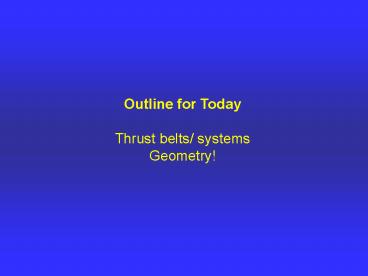Outline for Today Thrust belts systems Geometry - PowerPoint PPT Presentation
1 / 28
Title: Outline for Today Thrust belts systems Geometry
1
Outline for TodayThrust belts/
systemsGeometry!
2
The architecture of many fold-thrust belts
3
Himalayas
Strain can accommodate MAJOR shortening Stress
s1 is horizontal
Principal stress directions?
s1 is horizontal, s3 is vertical
4
Canadian Rockies
Thrusts root into a basal decollement, below
which shortening is accommodated by a different
mechanism decoupling between upper and lower
crust
5
may be higher-grade rocks and ductile shear zones
in hinterland
hinterland
foreland
low-grade rocks and brittle faults in foreland
6
thrust systems generally propagate toward the
foreland
7
Thrust system Geometry and Kinematics
There are 2 fundamental arrangements of
thrusts 1) Imbricate fans marked by a sole
(basal) thrust that has several branching splays
off of it - the fan opens upward, and 2)
Duplexes like an imbricate fan, but instead of
the faults splaying upward, they are cut by
another fault - the roof thrust. In this case,
the basal thrust is called the floor thrust.
8
Geometry- Imbricate fans
"thin-skinned" deformation
9
imbricate fan
10
Geometry- Duplexes
11
Development of duplexes
- Boyer Elliot (1982)
12
(No Transcript)
13
development of duplexes
14
map pattern of a duplex
15
Duplex terminology
16
Duplex terminology
Horses fault-bounded slices of rock, carried
along and within the fault zone.
17
Duplex Geometry
- Normal duplexes.
- 2) Antiformal duplexes.
- 3) Forwarded-dipping duplexes.
18
duplex outcrop-scale
19
Where is the duplex?
20
What is it?
21
The observation that faults do not continue
around the entire Earth suggests that they must
terminate Generally, a gradual decrease in slip
toward fault termination
22
Younger and structurally deeper faults lead to
rotation of older faults
23
Summary Thrust systems 1. Accommodate
significant crustal shortening 2. Basal
detachment decoupling within the crust 3. Faults
have ramp and flat geometries 4. Fault place
older/higher grade rocks over younger/lower grade
rocks 5. Faults cut up-section 6. Faults
generally propagate (get younger) toward the
foreland 7. Younger and structurally deeper
faults rotate older faults to steeper angles
24
What is it?
1. breached anticline
2. tip lines
4. klippe
7. blind thrust
5. window
6. lateral ramp
8. branch lines
25
Major issues
- mechanical paradox of thrusting - why such thin
sheets (e.g. 100 km long/2-3 km thick) can remain
intact during faulting? - What happened to the missing basement?
- Why are almost all faults dipping one way when
rock mechanics predict equal chance for both?
Next lecture (1) thrust belt mechanics (p.
336-339)(2) Discuss fault project
26
Summary Thrust systems 1. Accommodate
significant crustal shortening 2. Basal
detachment/decollement decoupling within the
crust 3. Faults have ramp and flat geometries 4.
Thrusts place older/higher grade rocks over
younger/lower grade rocks 5. Faults cut
up-section 6. Faults generally propagate (get
younger) toward the foreland 7. Younger and
structurally deeper faults rotate older faults to
steeper angles
27
What is it?
1. breached anticline
2. fault tips/ terminations
4. klippe
6. lateral ramp
7. blind thrust
8. branch lines
5. window
28
- Important terminology/concepts
- hinterland vs. foreland
- foreland propagation of thrusting
- thin-skinned vs. thick-skinned deformation
- blind thrust
- duplexes, their development, and map pattern
- roof thrust, floor thrust, and horses
- basal decollement
- hinterland vs. foreland deformation
- ramp-flat thrust geometries and terminology
- klippe vs. window
- allochthonous vs. autochthonous
- imbricate fan
- lateral ramp
- tear faults
- footwall synclines
- pop-up structures and backthrusts
- fault tips
- rotation of old faults during slip along younger
faults































